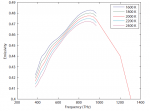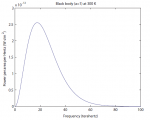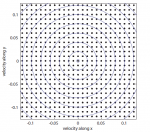All cars have to keep themselves cool. The reason for this, as we've seen, is the inefficiency of the engine: you can't convert the heat, made in the burning of gasoline, into work without creating some waste heat. If we take the energy stored in gasoline to be the "free energy" of the chemical bonds, …
Category Archive: Thermo for Normals
Feb 06 2013
Thermo for Normals (part 29): Radiation, continued
Now we know the amount of radiation coming from an object with a surface at temperature . And we know the amount for each frequency of light. It's where is frequency you're interested in, is the speed of light, and is a property of the object called emissivity. Emissivity measures the fraction of white light …
Dec 28 2012
Thermo for Normals (part 28): How things radiate
Every object, including you, radiates all the time. The radiation comes in the form of light, also known as electromagnetic radiation. Most of the time, this light isn't visible. Right now I'm radiating, and almost all of what is coming off is infra-red (IR), though there is also a tiny amount of radio, and microwaves. …
Dec 07 2012
Thermo for Normals (part 27): Diffusion and sound
The other day, my wife cooked up some microwavable popcorn while I was down the hall in the bedroom. The sound of the popcorn being made traveled seemingly instantly, but it took a full 5 minutes before the buttery smell came down the hall. Why is one so slow and the other so fast? Both …
Nov 20 2012
Thermo for Normals (part 26): A gas in detail
A molecule in a gas is being knocked into by lots of surrounding gas molecules. This is a very complex, almost random-seeming process. And yet we know that at higher temperatures the gas molecules simply must be moving faster on average. There must be a relationship between the temperature and the average energy. Moreover, we …









